A financial plan’s foundation includes:
- handling your living expenses comfortably,
- keeping adequate emergency reserves,
- protecting yourself and your family with insurance and
- making investments to help reach future goals.
Financial planners recommend saving at least 10% of your take-home pay. (And that’s if you start saving for your retirement in your 30s; the longer you wait to get started, the more you’ll have to save.) You should put this money aside first thing each month so that you won’t be tempted to spend it. Budget your expenses around what’s left.
Create your own emergency fund to cover unexpected expenses, such as sudden illness, or major car or house repairs. A reserve of two to six months’ of living expenses can prevent the need to dip into your savings. Set aside a small amount each month and keep it in a bank savings account, money market fund with check writing privileges, or other readily available place.
Insurance is designed to protect you from major financial losses such as death, disability, large medical expenses, or loss or destruction of your property. Choose the type(s) and amount of insurance that provide(s) the most security for you and your family.
In short, before you begin investing you should:
- make sure your income exceeds your expenses
- set up an emergency fund
- secure adequate insurance
- consider owning a house (mortgage interest is tax-deductible)
- consider buying a tax-deferred Individual Retirement Account (IRA)
- bring your debt repayment under control

